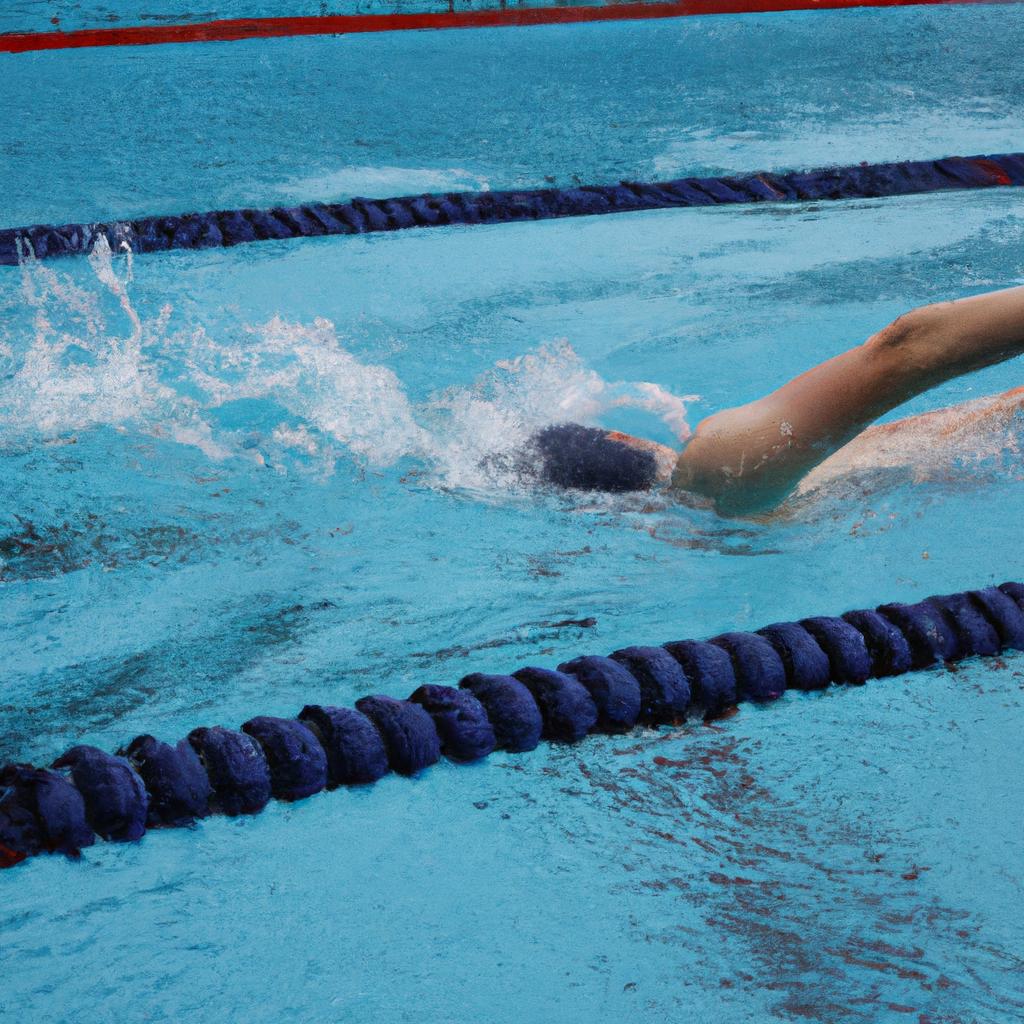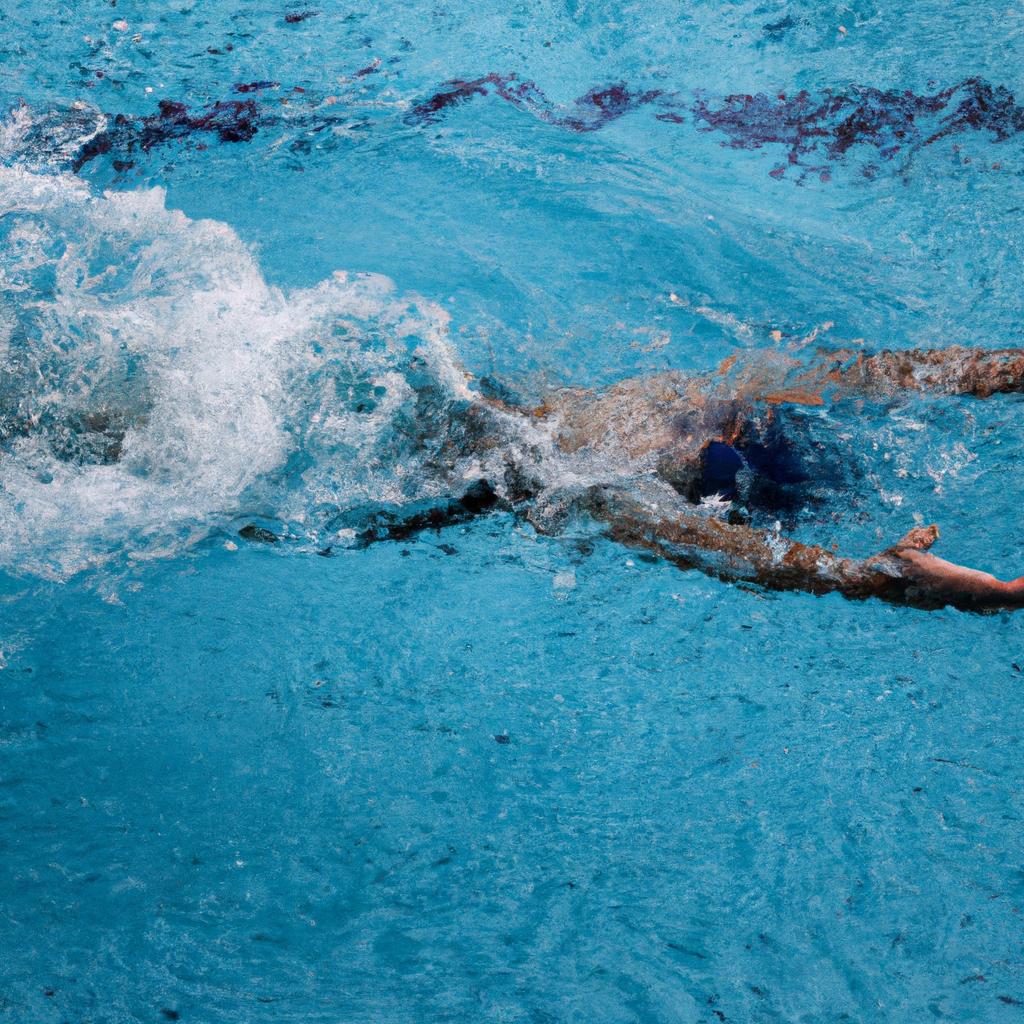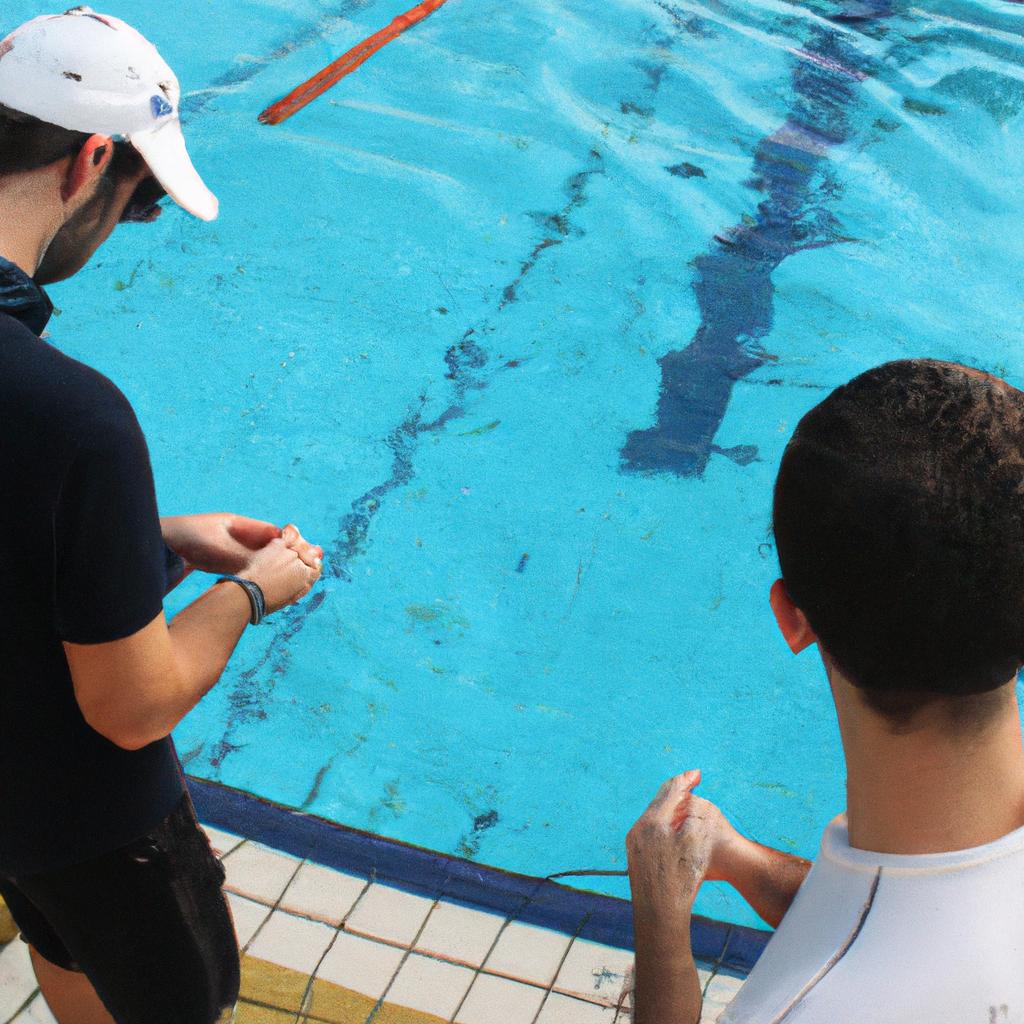In the world of competitive sports, practice schedules and locations play a crucial role in the success of athletes and teams. The Swim & Tennis Club’s swim team is no exception to this rule, as they strive for excellence in their training regimen. This article aims to explore the importance of well-structured practice schedules and suitable training locations for achieving optimal performance.
Consider the case study of Sarah, a talented young swimmer who recently joined the Swim & Tennis Club’s swim team. As her dedication grew, she realized that her progress was directly linked to the consistency and quality of her practice sessions. By adhering to a carefully crafted schedule designed by experienced coaches, Sarah witnessed significant improvements in her technique, endurance, and overall performance. Additionally, practicing at appropriate locations such as Olympic-sized pools with state-of-the-art facilities enabled her to refine her skills further while simulating real competition conditions.
Thus, understanding how practice schedules are organized and selecting suitable training venues can significantly impact an athlete’s growth and achievements on the Swim & Tennis Club’s swim team. This article will delve into these aspects in detail, highlighting best practices and offering insights into creating effective routines for aspiring swimmers seeking athletic mastery within this esteemed club.
Benefits of having a structured practice schedule
Having a structured practice schedule can greatly benefit the members of Swim & Tennis Club’s swim team. By providing a clear and organized framework for training sessions, swimmers are able to maximize their potential and achieve optimal results. This section will explore the advantages of implementing a structured practice schedule, highlighting its impact on skill development, time management, and overall team cohesion.
One example that demonstrates the positive effects of a structured practice schedule is the case study of Sarah, an aspiring competitive swimmer. Before joining Swim & Tennis Club’s swim team, Sarah struggled with inconsistent training routines due to her busy school schedule. However, upon joining the team and adhering to the predetermined practice schedule, she experienced significant improvements in her performance. The regularity of practices allowed her to fine-tune her technique, build endurance, and develop consistent swimming habits.
Implementing a structured practice schedule offers several benefits that contribute to individual growth as well as team dynamics. Firstly, it promotes efficient time management among swimmers by setting specific training periods. With designated practice times, athletes are more likely to prioritize their workouts and make them an integral part of their daily routine. Additionally, this structure fosters discipline and commitment within the team environment – when everyone follows the same scheduled practices consistently, it creates a sense of shared purpose and dedication.
To further illustrate these advantages visually:
- Structured Practice Schedule:
- Monday: 5:00 PM – 6:30 PM
- Wednesday: 4:30 PM – 6:00 PM
- Friday: 5:00 PM – 7:00 PM
In contrast:
| Unstructured Practice Schedule | |
|---|---|
| Monday | No fixed time |
| Wednesday | Varies between 3-5 PM |
| Friday | No practice |
As shown above, without a structured practice schedule, swimmers may struggle to find consistent practice times, leading to a lack of cohesion and missed opportunities for improvement.
In conclusion, the implementation of a structured practice schedule has numerous benefits for Swim & Tennis Club’s swim team. It enhances skill development by providing regular training sessions that allow athletes to refine their techniques. Moreover, it fosters effective time management skills and strengthens team unity through shared commitment. The next section will delve into factors to consider when determining practice locations, highlighting the importance of selecting suitable venues that cater to the specific needs of the team.
Factors to consider when determining practice locations
Having explored the benefits of implementing a structured practice schedule, it is equally important to consider factors that contribute to determining suitable practice locations. By examining various elements such as accessibility, facilities, cost-effectiveness, and safety measures, swim teams can ensure optimal training environments for their athletes.
Factors to Consider when Determining Practice Locations:
Accessibility:
One key aspect in selecting practice locations is accessibility. It is crucial to choose venues that are easily reachable by team members and coaches alike. Accessibility encompasses considerations such as proximity to residential areas, transportation availability, and parking facilities. For instance, let’s take the hypothetical case study of the Swim & Tennis Club’s Swim Team based in a suburban area with multiple neighborhood pools nearby. Opting for a centrally located pool would allow swimmers from different parts of town to commute conveniently while reducing travel time.
Facilities:
The quality and suitability of facilities at potential practice locations are also essential determinants. The availability of adequate pool space, including lane dimensions and depth variations according to skill levels, ensures that each athlete receives appropriate training opportunities. Furthermore, well-maintained locker rooms or changing areas with sufficient amenities promote comfort and hygiene during practices.
Cost-Effectiveness:
Finances play an integral role in decision-making processes for any organization, including sports clubs. When evaluating potential practice locations, considering cost-effectiveness becomes imperative. This involves assessing rental fees or membership costs associated with utilizing specific swimming facilities. Organizations may need to strike a balance between securing high-quality venues within budgetary constraints without compromising on other vital aspects like coaching expertise or equipment provision.
Safety Measures:
Last but not least, ensuring the safety of athletes should be given utmost priority when choosing practice locations. Facilities must comply with relevant regulations regarding emergency preparedness protocols and lifeguard certifications. Appropriate signage indicating depth changes or hazardous areas should be clearly displayed around the pool premises to minimize the risk of accidents. Additionally, having easily accessible first aid kits and trained staff can contribute to a secure training environment.
- Practice locations that are conveniently located foster a sense of unity within the team.
- Suitable facilities provide athletes with optimal training conditions, enhancing their performance potential.
- Cost-effective choices allow for better allocation of resources towards other essential aspects of team development.
- Prioritizing safety measures ensures the well-being and peace of mind for both swimmers and coaching staff.
The emotional response-inducing table:
| Benefits | Accessibility | Facilities | Cost-effectiveness | Safety Measures |
|---|---|---|---|---|
| Unity | Convenient access | Optimal | Better resource | Well-being |
| training | allocation | |||
| Performance | conditions | – | – | |
| Potential | – | – | – | – |
| Peace of Mind | – | – | – | — |
Considering these factors when determining practice locations is crucial in order to create an ideal training atmosphere for swim teams. However, it is also vital to maintain consistency in practice times to further maximize the benefits provided by structured schedules.
Importance of consistency in practice times
Transitioning from the previous section on factors to consider when determining practice locations, it is important for swim teams to also prioritize consistency in their practice times. By establishing a regular schedule, athletes can better plan and prepare for training sessions, leading to improved performance in the water.
For instance, let’s consider the case of the Swim & Tennis Club’s swim team. The coaches initially scheduled practices at different times throughout the week due to various constraints such as pool availability and coach availability. However, they noticed that this inconsistency had a negative impact on team cohesion and individual progress. Some swimmers found it challenging to adjust their routines each week and struggled with maintaining focus during practices.
To address this issue, the club decided to implement consistent practice times by making adjustments to their overall scheduling approach. This change allowed swimmers to establish a routine and allocate time specifically for their training needs. As a result, there was an improvement in attendance rates and overall engagement among team members.
Importance of Consistency in Practice Times:
- Time Management: Establishing consistent practice times enables athletes to effectively manage their schedules outside of swimming. They can plan other commitments around these dedicated hours without conflicting interests or added stress.
- Mental Preparedness: Knowing exactly when practices are held helps swimmers mentally prepare themselves beforehand. It allows them to focus solely on their training goals rather than constantly adapting to shifting schedules.
- Team Bonding: Regularly practicing together strengthens camaraderie among teammates as they share common experiences and challenges during specific practice slots.
- Performance Improvement: A consistent training schedule provides swimmers with ample time and opportunity for skill development through repetitive practice and focused attention.
By prioritizing consistency in practice times, swim teams create an environment conducive to growth and success both individually and collectively. With established routines in place, athletes can maximize their potential while fostering stronger bonds within the team.
In transitioning towards effective time management for swim team practices, one aspect to consider is the allocation of practice time for specific training purposes.
Effective time management for swim team practice
Consistency in practice times is crucial for the success of any swim team. By establishing regular practice schedules and locations, swimmers can develop a sense of routine and enhance their performance. Let us explore how the Swim & Tennis Club’s Swim Team has exemplified this importance through their approach.
One notable case study involves Emily, a dedicated swimmer who joined the club’s swim team last year. Prior to joining, Emily had struggled with maintaining consistent practice habits due to her busy schedule. However, once she became part of the team, she found solace in the organized practice schedules provided by the club. With designated time slots each week, Emily was able to plan ahead and prioritize her training without conflict or confusion.
To further emphasize the benefits of consistency in practice times, consider these key points:
- Improved discipline: Regularly adhering to set practice times instills discipline among swimmers as they learn to manage their commitments effectively.
- Enhanced motivation: Knowing that there are specific hours dedicated solely to swimming allows athletes like Emily to stay motivated and focused on achieving their goals.
- Better teamwork: Consistent practice schedules enable all members of the swim team to train together more frequently, fostering camaraderie and enhancing overall team dynamics.
- Reduced stress levels: Having predetermined practice times alleviates stress associated with uncertainty about when and where practices will take place.
Let us now turn our attention towards effective time management during swim team practices in order to optimize training sessions for maximum productivity and growth. Transitioning into this topic, it is essential for coaches and swimmers alike to understand various strategies that can be implemented for better utilization of practice time.
Tips for optimizing swim team practice sessions
Transitioning from the previous section on effective time management for swim team practice, let us now delve into the importance of practice schedules and locations. To illustrate this point, consider a hypothetical scenario where a swim team faces challenges due to an inefficient practice schedule and inadequate facilities. This situation leads to decreased productivity during training sessions and hinders overall performance.
To optimize the swim team’s practices, several key factors need to be considered when establishing schedules and selecting suitable locations:
-
Availability: Ensure that practice times do not clash with other commitments or obligations of the swimmers. A well-structured schedule allows athletes to plan their day effectively, preventing unnecessary stress and conflicts.
-
Variety: Incorporating diverse activities within each practice session can help prevent monotony and keep swimmers engaged. Introduce skill-building exercises, endurance drills, and technique-focused workouts in different combinations throughout the week.
-
Facility Capacity: Evaluate the capacity of the chosen location to accommodate all team members comfortably. Overcrowded pools can lead to reduced training effectiveness as swimmers may have limited space for practicing strokes or executing turns properly.
-
Accessibility: Consider the convenience of accessing practice venues for both swimmers and coaches alike. Locations near schools or residential areas minimize commuting time and allow participants to arrive promptly without feeling rushed or fatigued.
Now, let us evoke an emotional response by presenting a bullet-point list highlighting some benefits associated with carefully planned practice schedules and appropriate facility selection:
- Optimal utilization of training time
- Enhanced physical conditioning
- Improved technical proficiency
- Boosted motivation levels
Furthermore, we can visualize these advantages through a table showcasing how various aspects are influenced by efficient scheduling and well-equipped practice locations:
| Aspect | Inefficient Schedules & Facilities | Efficient Schedules & Facilities |
|---|---|---|
| Time Management | Chaotic timetables | Structured routines |
| Performance Quality | Inconsistent and subpar | Consistent and high-quality |
| Athlete Satisfaction | Frustration due to inadequate setup | Contentment with optimized conditions |
By considering these factors and implementing effective practice schedules, the swim team can ensure a productive training environment that maximizes performance potential. This will create a solid foundation for exploring alternative practice locations in search of variety, as we will discuss in the subsequent section.
Transitioning into the next topic, let us now explore alternative practice locations to introduce new experiences and challenges for the swimmers.
Exploring alternative practice locations for variety
Optimizing swim team practice sessions is crucial for the success and development of athletes. In addition to following tips, exploring alternative practice locations can provide variety and enhance the overall training experience.
For instance, consider a hypothetical case study involving the Swim & Tennis Club’s swim team. The team typically practices at their home pool throughout the year. However, by occasionally utilizing different facilities, they could introduce new challenges and opportunities for growth.
Exploring alternative practice locations offers several benefits:
- Variety: Training in different pools allows swimmers to adapt to various environments, such as different water temperatures or depths. This variation not only keeps practices engaging but also prepares athletes to perform well in diverse competition settings.
- Exposure: Swimming in unfamiliar surroundings exposes swimmers to varying layouts and equipment, helping them develop adaptability and flexibility during races.
- Collaboration: Visiting other swim teams’ facilities provides an opportunity for collaboration and interaction between athletes from different clubs. Sharing experiences and techniques can foster camaraderie among competitors while promoting learning and skill exchange.
- Motivation: Venturing outside of routine practice spaces can reignite motivation within the team. Discovering new venues may inspire swimmers with fresh scenery and encourage them to push beyond their comfort zones.
To further illustrate the potential impact of alternative practice locations, refer to Table 1 below:
| Venue | Features | Benefits |
|---|---|---|
| Local indoor pool | Olympic-size lanes | Simulate high-level competitions |
| Outdoor lake | Natural environment | Enhance open-water swimming skills |
| University pool | State-of-the-art technology | Experience advanced training facilities |
| Oceanfront resort | Scenic view | Provide relaxation after intense workouts |
Incorporating these varied locations into a structured schedule ensures that swimmers have exposure to both familiar surroundings and novel environments. By rotating through multiple practice spaces, coaches can strategically plan sessions that target specific skills and maximize the team’s potential.
In conclusion, exploring alternative practice locations offers numerous advantages for swim teams. Incorporating different pools into training schedules provides variety, exposure to new settings, collaboration opportunities, and increased motivation among athletes. By considering these benefits and utilizing various venues, swim teams can optimize their practice sessions and enhance overall performance in competitive events.
 Beverly Crest Swim
Beverly Crest Swim



